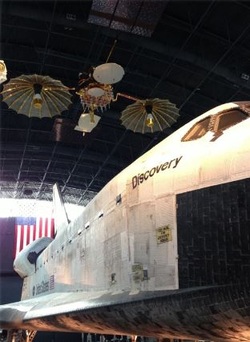365 Days
I felt the amazement of a child again last week as I gazed at “Orbiter Vehicle 103” (aka and more commonly known as Space Shuttle Discovery). She rests on display in the Udvar-Hazy Center of the Smithsonian Air and Space Museum near Washington, DC. Generationally, I’m supposed to be a Baby Boomer, although I believe we would be better described as the Space Age Generation; I grew up fascinated by and following this stuff, from John Glenn’s first flight in a Mercury capsule, to the televised moon landing, through the entire manned space program to the present, culminating in the Space Shuttle program. (Sadly, our Nation has taken a break from engaging in a vital space program, but that discussion is for another blog and time.)
Discovery spent 365 days in space – a full year – with 39 flights spanning 27 years. She traveled some 150 million miles during that period and capably accomplished every single type of mission that the Space Shuttle program supported. And she survived as a testament to
Engineering, Perseverance and the spirit of American Exploration.
A few other factoids support Discovery’s magnificence. She has 2.5 million separate parts and 230 miles of wiring; her three main engines are more powerful than twelve Hoover Dams, and the pressure of their turbopumps could send a column of liquid hydrogen 36 miles into the sky. Discovery can accelerate from standing still on the launch pad to 17,500 miles per hour in just a few minutes time.
It required a massive amount of energy to lift her into orbit from her launch pad. During takeoff, she consumed 45,000 gallons of liquid hydrogen and 17,000 gallons of liquid oxygen per minute; her solid fuel booster burned 660,000 pounds per minute. I find it difficult to imagine these figures, but what strikes me is that, once she made orbit, her rate of speed actually increased and the power required to keep her there was much less; the challenge shifted to the mission at hand and carefully navigating her through delicate maneuvers and finally guiding her back home safely again.
While perhaps not nearly as spectacular, launching a business is much like launching
the Space Shuttle. It requires integrating a countless number of elements and then applying massive energy to get it moving. If that process works as designed, a business eventually achieves orbit and gains speed. (We all know what happens when this process fails.) At that point, the effort shifts increasingly to sustaining momentum and carrying out the mission; this is delicate, thoughtful work, since unforeseen foreign objects appear ahead and gravity is always tugging at the enterprise. The stakes are high, but the journey is worth it. A business, like space exploration, must continually evolve to stay relevant for its time and to tackle the missions ahead.
It is stunning what Discovery’s crews accomplished in 365 Days of focused energy and passionate effort in flight, but even more spectacular to consider what it took to get her there. Thank you, Discovery, for your inspiration as the namesake to the sailing ships of exploration; to all who designed, built, flew and managed her many accomplishments, please accept the heartfelt appreciation of a generation of Americans.
Now pause to consider what you’ve accomplished in the past 365 days and through combined efforts with others. Next turn your eyes to the future and imagine what can be accomplished in the next 365 days; then go do that. Enjoy the Journey!
Discovery spent 365 days in space – a full year – with 39 flights spanning 27 years. She traveled some 150 million miles during that period and capably accomplished every single type of mission that the Space Shuttle program supported. And she survived as a testament to
Engineering, Perseverance and the spirit of American Exploration.
A few other factoids support Discovery’s magnificence. She has 2.5 million separate parts and 230 miles of wiring; her three main engines are more powerful than twelve Hoover Dams, and the pressure of their turbopumps could send a column of liquid hydrogen 36 miles into the sky. Discovery can accelerate from standing still on the launch pad to 17,500 miles per hour in just a few minutes time.
It required a massive amount of energy to lift her into orbit from her launch pad. During takeoff, she consumed 45,000 gallons of liquid hydrogen and 17,000 gallons of liquid oxygen per minute; her solid fuel booster burned 660,000 pounds per minute. I find it difficult to imagine these figures, but what strikes me is that, once she made orbit, her rate of speed actually increased and the power required to keep her there was much less; the challenge shifted to the mission at hand and carefully navigating her through delicate maneuvers and finally guiding her back home safely again.
While perhaps not nearly as spectacular, launching a business is much like launching
the Space Shuttle. It requires integrating a countless number of elements and then applying massive energy to get it moving. If that process works as designed, a business eventually achieves orbit and gains speed. (We all know what happens when this process fails.) At that point, the effort shifts increasingly to sustaining momentum and carrying out the mission; this is delicate, thoughtful work, since unforeseen foreign objects appear ahead and gravity is always tugging at the enterprise. The stakes are high, but the journey is worth it. A business, like space exploration, must continually evolve to stay relevant for its time and to tackle the missions ahead.
It is stunning what Discovery’s crews accomplished in 365 Days of focused energy and passionate effort in flight, but even more spectacular to consider what it took to get her there. Thank you, Discovery, for your inspiration as the namesake to the sailing ships of exploration; to all who designed, built, flew and managed her many accomplishments, please accept the heartfelt appreciation of a generation of Americans.
Now pause to consider what you’ve accomplished in the past 365 days and through combined efforts with others. Next turn your eyes to the future and imagine what can be accomplished in the next 365 days; then go do that. Enjoy the Journey!





